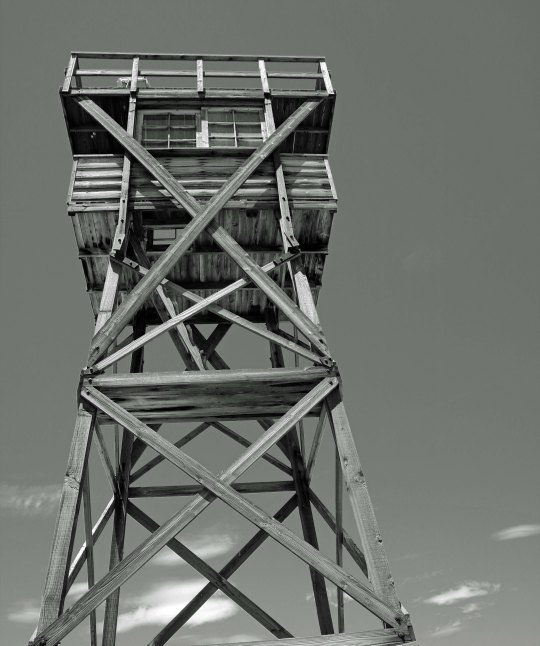
The World War II Japanese ‘relocation center’ of Manzanar is located a short ten miles north of Lone Pine and the Alabama Hills just off of Highway 395. I went there directly from the Lone Pine Museum of Film History. It would be hard to find two more different reminders of our past. As far as I can remember, I didn’t know about the site until I was in college. It wasn’t something that was discussed at my home. Had I been an American citizen with Japanese ancestry as opposed to British ancestry, it’s likely that I would have been born at one of the West Coast “relocation centers,” i.e. concentration camps, behind barbed wire fences overlooked by guard towers bristling with guns.
I may have learned about the camps in high school during American History but it was made real for me at the community college I attended just east of Sacramento in 1961-63. I was student body president in 1962 and a member of my council was a young Japanese American woman who had experienced the relocation effort directly. Her family, along with several other Japanese American farmers in the Loomis/Lincoln area, were rounded up, forced to abandon their farms, and shipped out to Tule Lake where the relocation center for most of Northern California was located.
Ten years later in the early 70s, I would come to know another Japanese American who had been shipped along with his family to Tule Lake as a six-month old child, Bob Matsui. In 1971, working together with other environmentalists, I had created a political organization in Sacramento to elect environmentally concerned candidates to the Sacramento City Council and Board of Supervisors. Bob, who was making his first run for city council, had scored high on a questionnaire that we had put together. I had enthusiastically supported him in his run for election and he had won. Not only did he support environmental issues on the City Council for seven years, he continued to in 1978 when he became the fifth Japanese American to be elected to Congress. He would serve with distinction for a quarter of a century and be known for his bipartisan approach in creating substantive legislation.
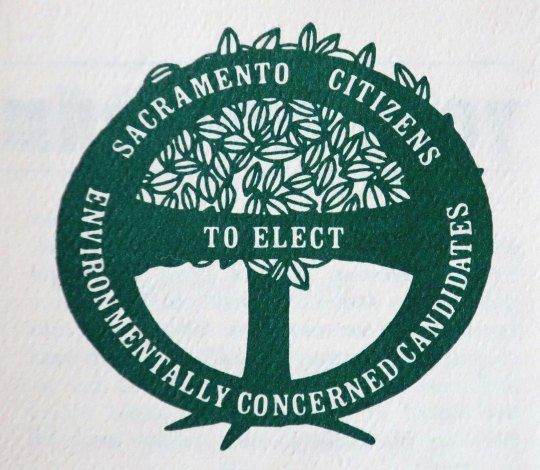
More to the point of this post, Bob also became a strong advocate for recognizing the wrongs that had been done to Japanese Americans during World War II. For one, he was instrumental in having Manzanar set aside as a National Historic Landmark. In 1980 he joined Senator Daniel Inouye, and Congressmen Spark Matsunaga and Noman Mineta, in an effort to establish a committee to study the effects of the incarceration and the potential for redress.The end result of this effort was the creation of the Commission on Wartime Relocation and Internment of Civilians. After an extensive set of hearings throughout the West, the bipartisan Commission concluded that the decision to incarcerate the Japanese Americans was not based on military necessity and instead was based upon “race prejudice, war hysteria, and a failure of political leadership.” Not one Japanese American was found guilty of aiding Japan during World War II.
The findings of the Commission led to the Civil Liberties Act of 1988 which granted wartime survivors an apology and individual reparations of $20,000. While President Reagan initially opposed the implementation legislation, H.R. 422, because of cost, he readily signed the bill when it reached his desk. I found his comments at the signing ceremony to be quite relevant, not only to the legislation, but for today.
He had started the ceremony by noting “… we gather here today to right a grave wrong. More than 40 years ago, shortly after the bombing of Pearl Harbor, 120,000 persons of Japanese ancestry living in the United States were forcibly removed from their homes and placed in makeshift internment camps. This action was taken without trial, without jury. It was based solely on race, for these 120,000 were Americans of Japanese descent.”
Reagan went on to describe H.R. 442: “The legislation that I am about to sign provides for a restitution payment to each of the 60,000 surviving Japanese-Americans of the 120,000 who were relocated or detained. Yet no payment can make up for those lost years. So, what is most important in this bill has less to do with property than with honor. For here we admit a wrong; here we reaffirm our commitment as a nation to equal justice under the law.”
The President concluded his statements by reading a newspaper article from 1945 that had been included in the Pacific Citizen:
“Arriving by plane from Washington, General Joseph W. Stilwell pinned the Distinguished Service Cross on Mary Masuda in a simple ceremony on the porch of her small frame shack near Talbert, Orange County. She was one of the first Americans of Japanese ancestry to return from relocation centers to California’s farmlands. “Vinegar Joe” Stilwell was there that day to honor Kazuo Masuda, Mary’s brother. You see, while Mary and her parents were in an internment camp, Kazuo served as staff sergeant to the 442d Regimental Combat Team (an all Japanese-American regiment). In one action, Kazuo ordered his men back and advanced through heavy fire, hauling a mortar. For 12 hours, he engaged in a singlehanded barrage of Nazi positions. Several weeks later at Cassino, Kazuo staged another lone advance. This time it cost him his life.”
The newspaper clipping noted that her two surviving brothers were with Mary and her parents on the little porch that morning. These two brothers, like the heroic Kazuo, had served in the United States Army.
After General Stilwell made the award, the motion picture actress Louise Allbritton, a Texas girl, told how a Texas battalion had been saved by the 442d. Other show business personalities paid tribute — Robert Young, Will Rogers, Jr. And one young actor said: “Blood that has soaked into the sands of a beach is all of one color. America stands unique in the world: the only country not founded on race but on a way, an ideal. Not in spite of but because of our polyglot background, we have had all the strength in the world. That is the American way.” (Italics mine)
Reagan then went on to note with his usual sense of humor: “The name of that young actor — I hope I pronounce this right — was Ronald Reagan. And, yes, the ideal of liberty and justice for all — that is still the American way.”
Now that’s what being Presidential, the President of all Americans, is about. Following are several photos I took at Manzanar.
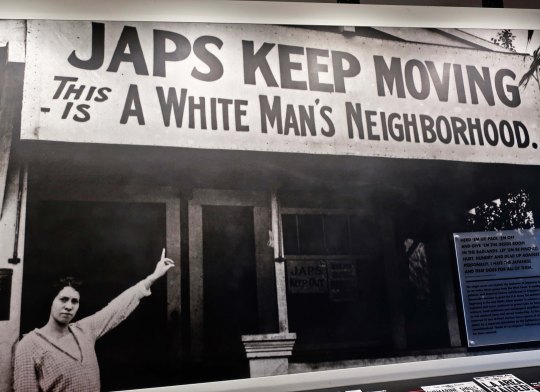
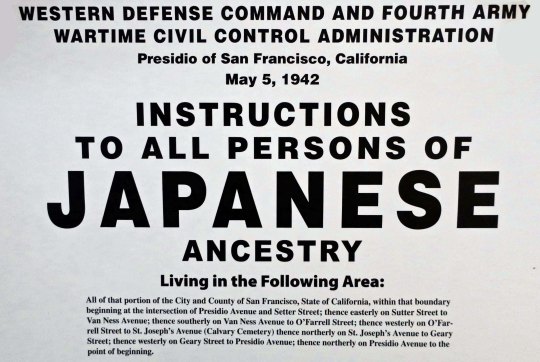


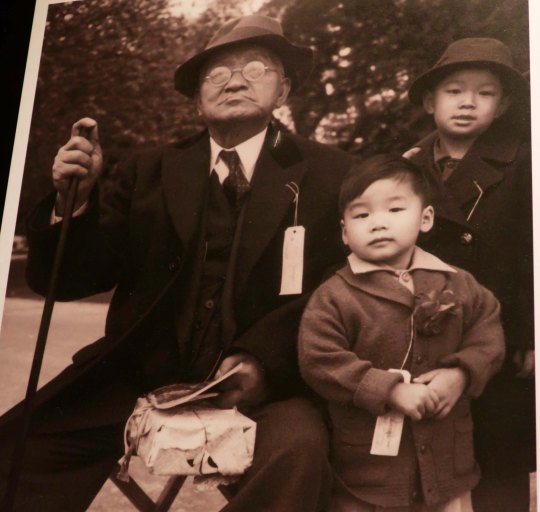
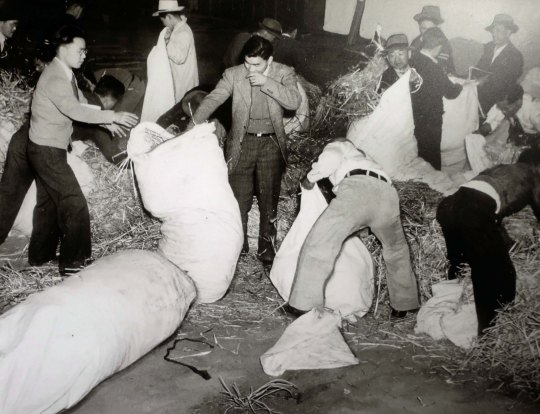

Privacy was extremely limited. Both inside and out.
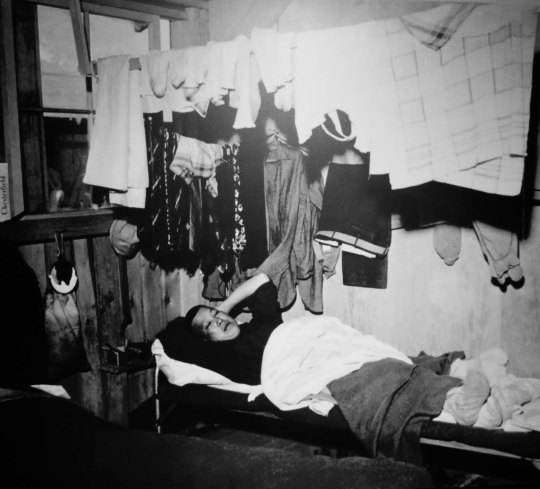
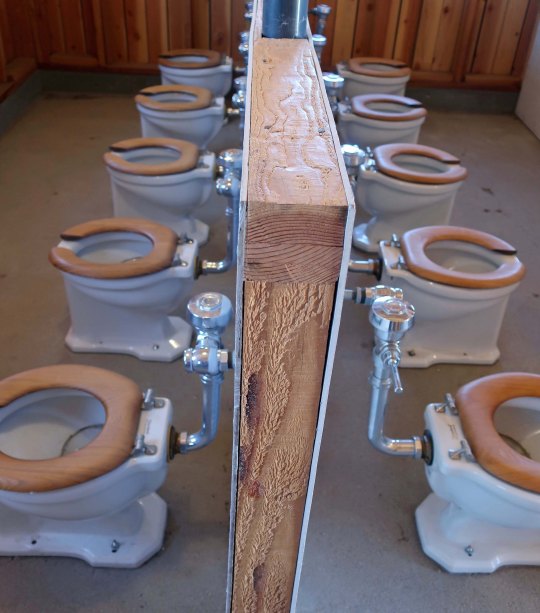
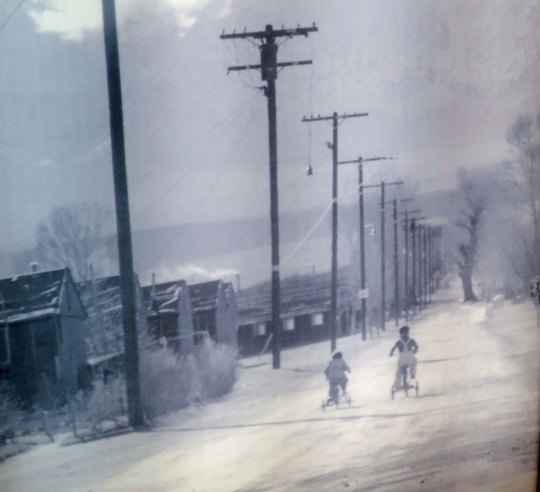
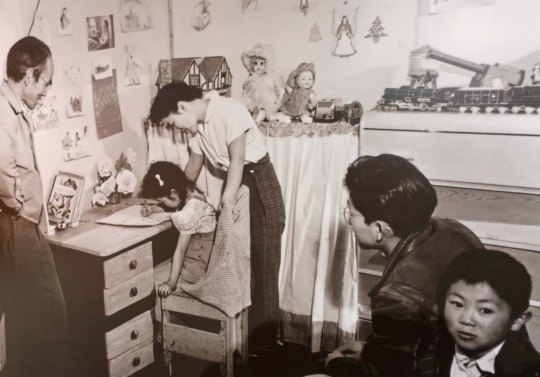

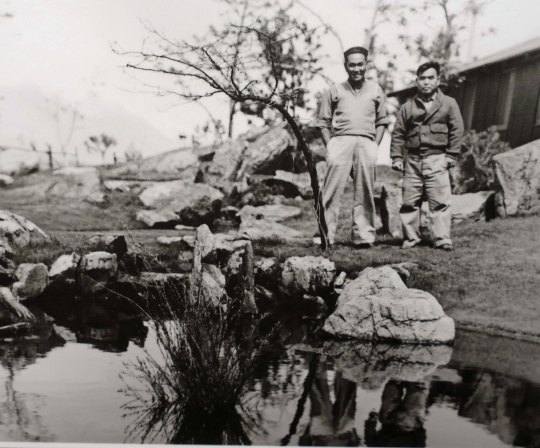
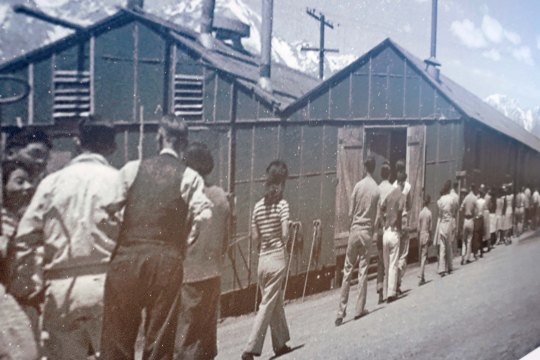



“Oh, give me land, lots of land under starry skies above. Don’t fence me in. Let me ride through the wide open country that I love. Don’t fence me in. Let me be by myself in the evenin’ breeze, And listen to the murmur of the cottonwood trees. Send me off forever but I ask you please, don’t fence me in”
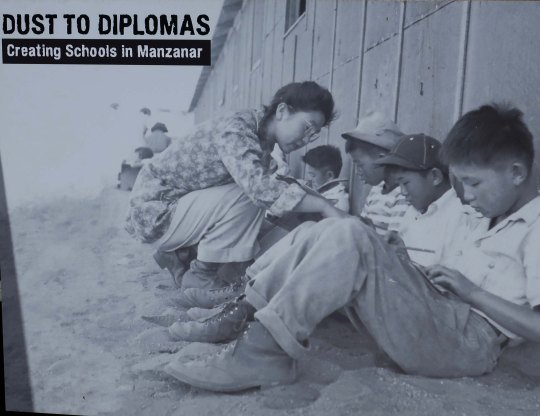

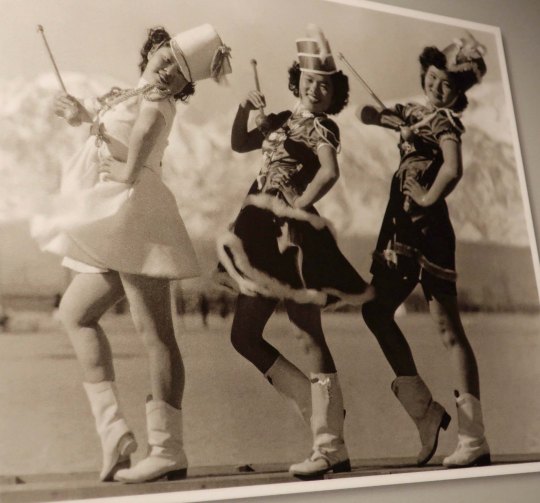
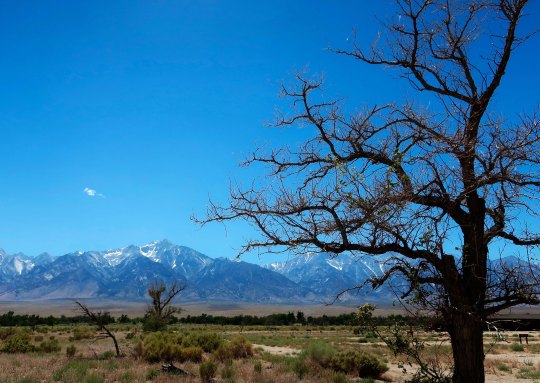
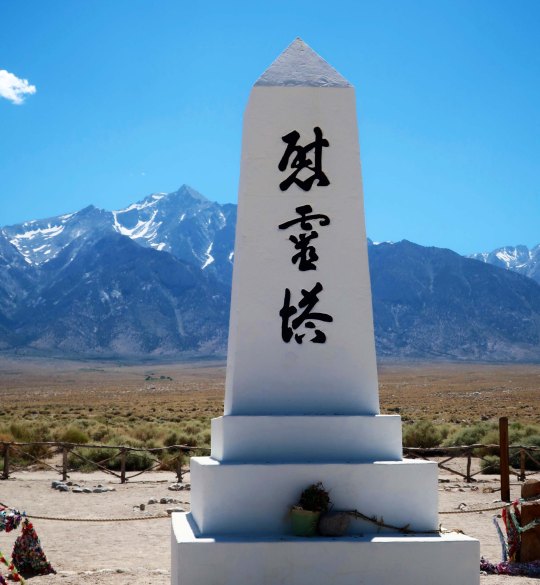
NEXT POST: The number one reason for driving down Highway 395: Its dramatic mountain scenery.
Curt, your story is strong and emotional. I didn’t know these facts about people already living in the conuntry. It is so sad to hear the prejudices and yet you lift
our hearts with the tales of how with positively many of the imprisoned made their lives happier. Creativity in so many areas flourished.
Yes, the area is beautiful and I so understand why you love it.
Miriam
Thanks, Miriam. I thought Manzanar is a great reminder of the tremendous damage caused by prejudice, and the damage it can do to all of us, but is also, as you mentioned, serves also as a reaffirmation of the human spirit. –Curt
Thank you Curt for this post. Perhaps 75 years from now someone like you will post the story of the tragedy going on right now on our southern border.
David
Thank you, David. And one would hope that it doesn’t take 75 years. What is happening in America today was on my mind with every word I wrote. –Curt
Another excellent post, Curt- this is history that shouldn’t be forgotten!
Interesting timing- the kids and I just visited the memorial to the Japanese Americans relocated from Bainbridge Island, WA, and I was planning on posting on it in a couple of weeks- may I link to this article to send people over here, too, when I do?
Absolutely, Anne. And thank you.
Another excellent post Curt. I did not know Bob Matsui had been interred.
There was an interesting piece on CBS Sunday morning December a year ago about how former Senator Simpson of Wyoming visited a camp near Cody, Wyoming as a boy scout and formed a life-long friendship with Norm Minetta who was interred there. They both served in an era when Members of Congress recognized “people of good will can differ.”
Thanks Ray. And you are so right. Good politics, as I learned in my political science classes at Berkeley (Matsui graduated two years before I di with a degree in Poly-sci) is the art of compromise. The demise of bipartisanship in our legislative bodies is one of the greatest problems we face. –Curt
Been there many times and my childhood friends parents were there. His father a famous scientist and his mother a nurse.
I think one of the reasons that the Japanese Americans were so good at making the best of their incarceration was the incredible talent they had among them. Such a loss to our country at that time. –Curt
Excellent post. I used to be checking constantly this
weblog and I’m impressed! Very useful info particularly the closing part 🙂 I handle such info
a lot. I was looking for this particular information for a very
long time. Thanks and best of luck.
I’m pleased that you found it useful.
The Executive Order by FDR was totally illegal and it is an embarrassing episode of history. But it is in hindsight that we condemn these actions the loudest. Italians and Germans were also put in camps. This war changed the world in so many ways and fear makes people act like they never would otherwise.
I think Roosevelt’s actions fit under the category of “failure of political leadership,” G. Thanks for your comments as always. Given your extensive knowledge of WWII you may have better figures than I do, but my research showed that 250 Italians were put in detention camps and some 11,000 germans, none of whom were American citizens. Approximately 80,000 of the 120,000 Japanese put into detention camps were American citizens. Of the 30,000 Japanese who weren’t citizens at the time, most of them weren’t because of the 1920 immigration laws that didn’t allow them to become naturalized American citizens, a problem that the Germans and Italians didn’t face. Having noted this, I am sure that both Germans and Italians were discriminate against in America during the war, but if I had my druthers, I would have preferred to be a German or and Italian than a Japanese. My “lest we forget” applies directly to your comment on hindsight. While my post reflected an historical incident, the value of history is it should help us to avoid similar mistakes in the present and in the future. As always, I appreciate your input. –Curt
Please don’t think I was down-playing what happened to the Japanese/Americans. That was an awful part of the war. There were far more Italians and Germans interned than your figures and many were citizens, but they were not classified as harmful to the country the way the Japanese were. Citizens of the US could relate to Europeans far better than the Orientals who had a completely different culture than they were used to. Much of that happened because of political pressure from high-standing Democrats in California who wanted the Japanese out so they could take over their lands. In my book, “failure of political leadership” is an understatement!
Thanks for pointing out the influence of economic interests in California (although I suspect that there were a few Republicans involved as well, G :)). Greed and prejudice often go hand in hand. –Curt
Thank you for writing this Curt. History repeats itself, and it is tragic.
Some battles we have to fight over and over, Sylvia!
I am not sure that we should be judgmental about such things. Should we retrospectively disapprove ? Personally, I don’t think so. These were desperate times. In the UK German citizens were rounded up and sent to an internment camp on the Isle of Man. Maybe there was an element of extreme paranoia but then again the world was at war. Should a statue of Cecil Rhodes at Cambridge University be removed because he lived over a hundred years ago by different values? The World now seems to have a compensation culture.
I suspect Andrew, that we have all done things in our past that we wished to heck we hadn’t. And I am a great advocate of move on. Certainly for myself, so why wouldn’t I be for others? What is more important is what we do today and tomorrow. What lessons have we learned? And I was impressed with Ronald Reagan’s reaction who in nobody’s definition was noted for ultra liberal or even moderately liberal stands. The reality of America, as Reagan put it, is we are a multi-ethnic nation, and that is an important part of who we are. The question from my perspective is how to take advantage of those various strengths to make America a better nation so everyone can benefit, not just a few. In the long run it will make for a much healthier nation. Thanks for your thoughts, as always. –Curt
In 2005 in an American TV series poll of viewers Ronald Reagan was voted the Greatest ever American, coming in ahead of Washington, JFK, both Roosevelts and even Abraham Lincoln. Would you agree?
Put me on the spot would you, Andrew. 🙂 No one beats Washington and Lincoln in terms of defining America. You would have a significant difference between thoughtful Republicans and Democrats regarding Reagan. Not so with Washington and Lincoln. –Curt
Sitting on the fence then Curt, watch out for the splinters!
Winston Churchill was voted the greatest Briton which was entirely predictable but those who voted overlooked a lot of other suitable candidates. I myself would have gone for Thomas Cromwell but he didn’t even make the short list!
Laughing, Andrew. The truth is that Reagan and I were on the opposite side of the fence on most issues, starting way back in my days at Berkeley. My main concern was his stand on environmental issues. Even given all of that, he was not a bad governor or president. This, of course, is my perspective. I realize that others have a much different view. 🙂 In the long run, history is much better judge of greatness.
Wow, Curt. I really want to see this. Like you, I didn’t learn about the Japanese Internment Camps until I was in college. It’s amazing how much nasty history gets covered up. I recently learned a little more about the German scourge in Cincinnati during the war. Many people living there tried to rid themselves of being identified as German in a very German town. But that’s nothing like what was happening on the West Coast. I have read a few memoirs about that time from Japanese survivors, but I’d like to learn so much more about what happened.
There was no lack of prejudice against Germans and Italians regardless of the fact that they were loyal Americans who believed in the nation and its democratic principles, Juliann. The Japanese just paid a greater price. Thanks. Curt
A great post, Curt. So much to learn. I never knew this part of the history.
Thanks, Gerard. The lessons of the internment always deserve repeating. Especially in our world today. –Curt
A relevant post to what is going on in the world today. I was a refugee in Germany at the end of WW II and we were in the American zone. I was only 5 years old when we managed to emigrate to the USA, but my first several years were spent in a displaced persons camp supported by the USA. The situation was dire for all the displaced refugees in the aftermath of that war, but we were supplied with the basic necessities to survive thanks to the charity of the Allies, or in our experience it was the USA that saved me and my family. Some policies can certainly offset examples that you highlight in your post. I’m not sure how many folks are aware of the good that was done in the aftermath of that horrendous war. I, for one, am ever grateful for the good that was done to offset the not so good.
Thank you for sharing your personal story, and a perspective that – you are right – isn’t heard very often.
Thanks, Crystal. Knowing people who were impacted by any particular historic event of consequence always provides a unique perspective. –Curt
There are many more times I am proud of our nation and what it stands for on issues of generosity and fairness and equality than not, Gunta. But when it strays, it can really stray. –Curt
You tell the human story most affectingly here, Curt, and your references to Ronald Reagan are very telling. ‘Not in spite of but because of our polyglot background, we have had all the strength in the world … ‘ and, years later, ‘yes, the ideal of liberty and justice for all — that is still the American way.” As you say, Presidential …
I didn’t always agree with Reagan, Dave. In fact there were issues I seriously disagreed with him on, especially in the area of the environment. But there is no doubt that he had the interest of America at heart and was willing to work in a bipartisan way on critical issues. I thought his statement was very powerful. –Curt
Bipartisan, important word when it comes to striking deals that last!
And a seemingly lost skill, Dave. Here’s hoping that the world can return to a degree of sanity.
Curt this post is really well done. Thank you for the work you put into getting so much information in here. I truly knew nothing about Japanese Internment until I was an adult. It is a shame that kids aren’t educated about all of our history- especially the times when we made mistakes. Andrew’s point about not criticizing people’s behavior when they acted in different times made me think that everyone should at least be taught what happened. After my public education, I had been led to believe that the United States was a bastion of righteousness and filled with people who are innocent of heinous crimes committed elsewhere in the world. I think we should condemn those leaders of the past whose actions are shameful to us now, because it’s no secret when an influential person is promoting fear – eg POTUS – and people of their time certainly knew it was wrong. But even if we don’t do that, we need to teach children that the behavior was reprehensible, and we are in danger of repeating it. We are all susceptible to bad behavior/ statements/ decisions based in fear and not reality. There are so many shocking examples of crimes against humans of a different cultural group in this country – so many. But it’s not taught enough in schools! If we grow up understanding how easy it is to fail like that, maybe we would be better at stopping this kind of stuff in the moment.
Living in Portland I finally got a more personal look at the story, and met a couple of U.S. veterans of Japanese descent from the Hood River, Oregon area who told me more. Often there was no one to look after the property when the family was sent to the camp. Their homes and businesses were occupied after they left. Over the years that they were gone, people came in and stole from them, or in some instances, took over their businesses and strangers began making money from their assets. In the cases I heard about, once they were allowed to return, no effort was made to restore the fruit orchards to the families so that they had a way of making a living when they got back to Hood River. They had to start all over.
The men I talked with said that nearly all the eligible Japanese-American men in their camp joined the military and it was not simply because they were loyal to the US, but primarily out of severe boredom. These 20-something young men had no occupations and were not allowed to leave the camp. Joining the military was the only way to get out, and many gladly took that option.
Discrimination against Asians started with the Chinese and was passed on to the Japanese, Crystal. Immigration laws were passed in the 20s to block Japanese from coming to America. There was strong opposition to Japanese-American farmers at the time and up to World War II because the Japanese farmers were more successful because of different farming techniques. Many of these farmers pushed hard for the interment camps to eliminate competition and to open up more farming land for themselves. Prejudice and greed often go hand in hand, as the Cherokees learned. –Curt
Curt,
Great Story, but horrible times. It seems that history is repeating itself which saddens me. I passed the sight a few times not knowing what was until I looked it up. I told my husband that on the way back I wanted to visit the site. It’s hard to imagine it without buildings or fences, but the pictures helped to put in perspective the area of the massive incarceration of persons who were wronged.
Thanks. Horrible indeed. And the parallels with today are frightening, to say the least. The visitor center at Manzanar provides an excellent overview. Definitely worth a stop. I had passed it by many times as well. –Curt
Curt after reading your article I am left with shivers from head to toe. The camps happened here in Canada as well but like you I knew very little about them in my school age years.I can barely stand to read the reports of your southern border. Let us all hope that history is not attempting to repeat itself.
What’s happening on the border is scary, Sue. What’s happening in America is scary. What’s happening in the world is scary. Fun times, eh. Let’s hope for more rational times in our future. –Curt
Let us truly hope Curt. I sometimes wake up and wonder what planet I’m on.
The Third Rock from the Sun can get pretty weird!
Follow another blogger whose family was interned. Horrible blot on history.
Yes it was, AC. Hysteria and prejudice are powerful, negative forces. And, in this case, topped off by greed. –Curt
Fascinating, Curt – I’d love to visit. I read Farewell to Manzanar many years ago (twice actually), and it has always stuck with me. The parallels to today make me sick at heart.
If only we could learn from history, Lexi. Man’s inhumanity to man never seems to cease. –Curt
“prejudice, war hysteria, and a failure of political leadership”. Sounds all too familiar. I wonder what future generations might think of today’s internment camps on the Mexican border.
Hopefully with the same mortification we look back on the internment programs of WW II, Dave. Given the separation of families, what’s happening now may be worse. –Curt
It’s easy to draw parallels between Manzanar and our southern border, but there are other, equally distressing currents running through our society today. In Marysville, Michigan, a candidate for city council has declared that the city should remain “as white as possible.” It was the third photo above that brought that article to mind, and collapsed the space between the 1940s and today.
Some of the same problems were faced by the Vietnamese who came here to Texas in the 1970s. The “shrimper wars” were a real thing, and I work very near a harbor that was known as Little Hanoi. There weren’t any actual detention camps in that situation, but the isolation and persecution of the Vietnamese was real. If the interned Japanese and the Vietnamese refugees had anything to give thanks for, it might have been that social media didn’t exist in those days. I’m against censorship in any form — yes, even “hate” speech — but on the other hand, our modern technology is being used to do tremendous damage to individuals and groups, and it’s ever more difficult to figure out what to do about that.
It’s incredibly hard to get beyond perceived self-interest, Linda. Almost impossible. I am convinced that any hope for the future has to be tied to redefining self-interest. The world we live in today is radically different than the world we lived in 20 years ago which is nothing compared to the world of 200 years ago. And the rapid change seems to be accelerating. And much of how we deal with the change is with the same mind and tribal mentality that was working for us 2,000 or 20,000 years ago. I for one, like the concept of enlightened self-interest, where we look beyond the present into the future as an ongoing process. And it doesn’t even have to be very far. I think the new Statement on Purpose of a Corporation that was drafted by a number of America’s business leaders is an excellent example.
Thanks as always for your thoughtful comments. –Curt
Interesting that there’s a parallel to our southern border situation now in South America. With Ecuador’s new visa restrictions in place, Venezuelan refugees caught in Columbia are talking about crossing the Ecuadorian border between checkpoints in an attempt to get to Peru. And American media is focused on a football quarterback who’s retiring, or giving oxygen to people whose self-interest is anything but enlightened. Sigh.
Double sigh. Hopefully there will be a solution next year. If not, we are in a world of hurt. But then again, we already are.
Pingback: Visiting the Bainbridge Island Japanese American Exclusion Memorial